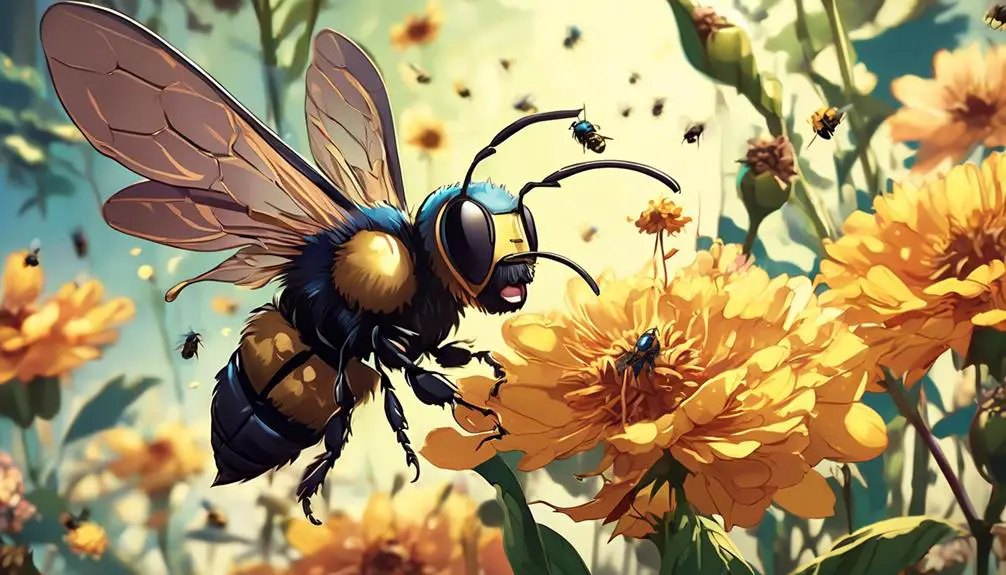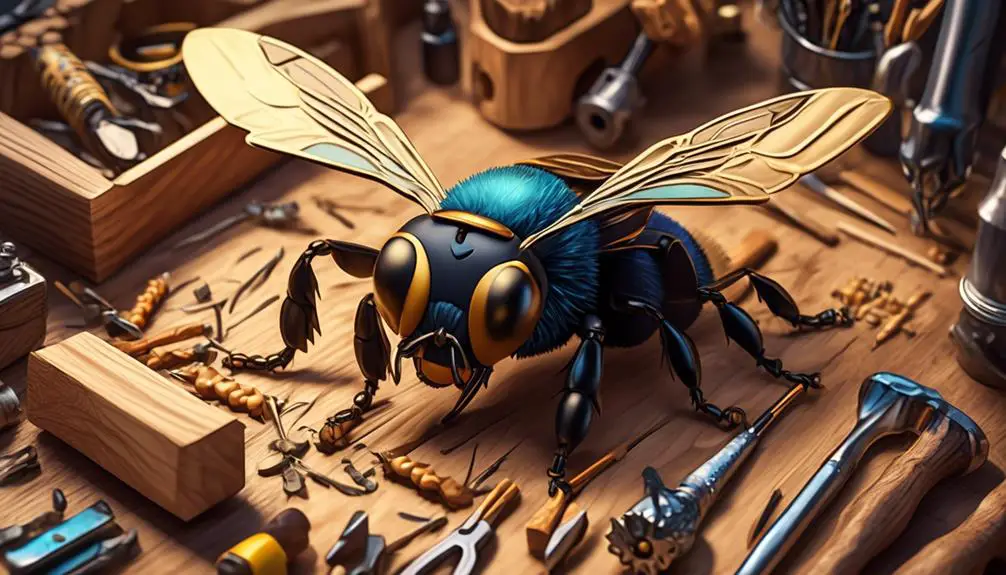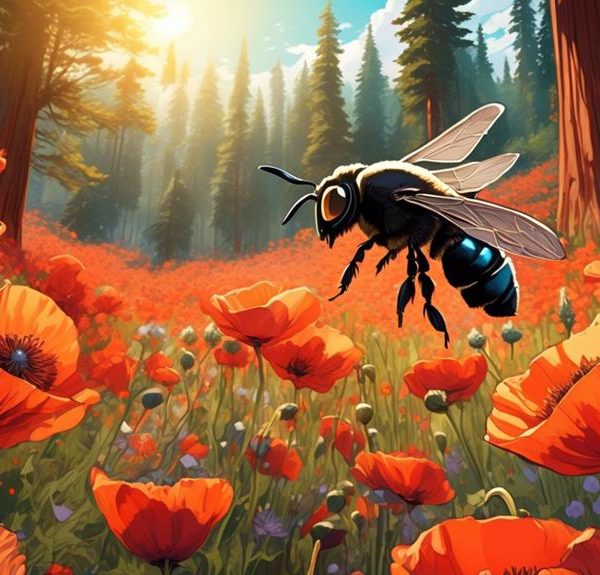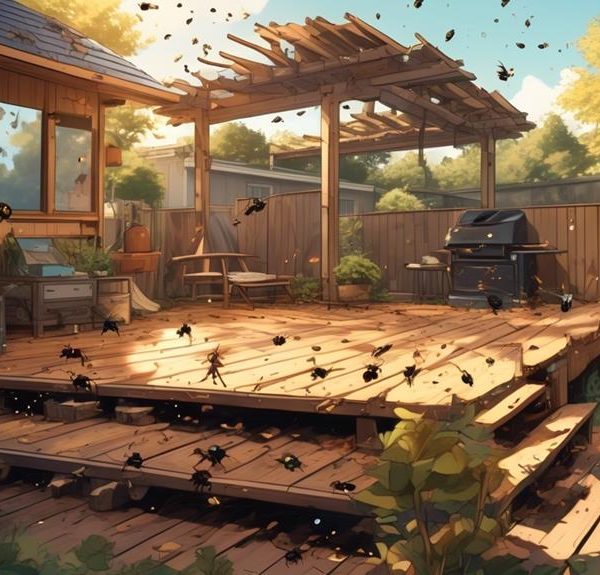Uncover the intriguing mystery of wingless carpenter bees and the impact on their lifestyle in this eye-opening read.

Carpenter Bee No Wings
You've probably seen a carpenter bee buzzing around, its wings a blur of motion. But did you know, there can be instances in which these industrious insects are wingless?
Yes, it's a rather unusual phenomenon in the insect world, often leaving many baffled. Just imagine, a bee with no wings, sounds quite intriguing, doesn't it?
Without giving too much away, let's just say that this curious aspect of carpenter bees carries a host of implications worth exploring. Stick around, and you'll discover the reasons behind this oddity, its impact on the bees' lifestyle, and more.
Key Takeaways
- Carpenter bees are important pollinators and play a crucial role in local ecosystems and agriculture.
- Wingless bees, including wingless carpenter bees, are an anomaly caused by environmental stressors or genetic mutations.
- Male carpenter bees are naturally wingless as part of their mating strategy, allowing them to protect their nests and fight off rivals.
- The absence of wings greatly impacts the lifestyle and behavior of wingless carpenter bees, limiting their mobility and ability to gather food and mate.
Understanding Carpenter Bees

While you may associate bees with their ability to fly, it's essential to understand that Carpenter bees, in particular, have a distinct lifestyle and characteristics that differentiate them from their winged counterparts. Carpenter bees are solitary creatures, unlike honeybees or bumblebees that live in colonies. They earn their name due to their unique nest-building behavior, burrowing into wood to lay their eggs.
You'll notice that male Carpenter bees lack a stinger, while females do posses one but are typically non-aggressive unless threatened. Their size and color also distinguish them, as they're larger than most bees and exhibit a shiny, metallic blue-black sheen.
Now, let's delve into their ecological role. Carpenter bees are effective pollinators. While they can sometimes be seen as pests due to their wood-boring habits, it's their ability to pollinate a wide variety of plants that contribute significantly to local ecosystems and agricultural systems.
Understanding Carpenter bees allows you to appreciate their importance in the grand scheme of biodiversity. So the next time you spot a large, shiny bee buzzing around, remember it's more than just a pest, it's a crucial player in the environment.
The Phenomenon of Wingless Bees

Diving into the phenomenon of wingless bees, you'll find it's a fascinating anomaly that defies our typical understanding of these buzzing insects. Most often, it's not a natural occurrence but a result of environmental stressors or genetic mutations that these bees lose their wings.
You might wonder how a bee survives without wings. It's not easy, but they've adapted to ground-based life. They can crawl and scuttle, but they can't perform their usual pollination duties. This affects the ecosystem as bees play a significant role in pollination.
Investigating further, you'll find that wing deformities can also be a symptom of a viral infection, like the Deformed Wing Virus (DWV). DWV is primarily transmitted through the parasitic Varroa mite. You'd also find instances where pesticides have been linked to wing deformities in bees.
In the case of carpenter bees, you'll notice that the males are often wingless. This isn't because of a disease or environmental factor, but a characteristic of their gender. The males are born without wings and are confined to the nest, guarding the eggs and larvae.
Causes Behind Wingless Carpenter Bees

Having explored the general phenomenon of wingless bees, let's now focus specifically on the causes behind wingless carpenter bees, particularly the males, who are born without the gift of flight.
You may think it's a genetic defect, but it's not. Carpenter bees have evolved this way for a reason. The primary cause is sexual dimorphism, a common trait among insects where males and females have distinct differences beyond just their reproductive organs. In the case of carpenter bees, males are born without wings.
The underlying reason lies in their mating strategy. Male carpenter bees are territorial, spending most of their time fighting off rivals and seeking out receptive females. Flying would expend valuable energy that could be better used in these pursuits. Additionally, being grounded allows them to stay close to their nests, protecting them from intruders.
Males also have large, conspicuous eyes, which are more adapted for spotting moving objects on the ground rather than in the air. These evolutionary adaptations point to the fact that for male carpenter bees, wings are superfluous; they're not essential for their survival or reproductive success.
In nature, it's all about efficiency and adaptation. And for these wingless wonders, they've adapted perfectly to their ground-bound existence.
Impact on Bee's Lifestyle and Behavior

Remarkably, the absence of wings profoundly influences the lifestyle and behavior of male carpenter bees, shaping their daily routines and interactions. Without wings, they're unable to fly and gather food, which greatly affects not only their survival but also their role in the ecosystem.
Here's a brief table to illustrate the changes:
Behavior | With Wings | Without Wings |
|---|---|---|
Food Gathering | Flies to collect nectar and pollen | Depends on ground-based sources |
Mating | Flies to find and court females | Struggles due to limited mobility |
Escaping Predators | Escapes by flying away | More vulnerable, relies on hiding |
Nesting | Prefers wooden structures, often high up | Limited to ground-level or accessible spaces |
Social Interaction | Regular interaction with other bees | Isolates due to limited mobility |
You can see how winglessness significantly alters the carpenter bee's way of life. They're more vulnerable to predators and have difficulty mating. Their food sources become limited, affecting their health and lifespan. This lack of mobility also isolates them, which can impact their overall well-being. Understanding these impacts is essential in aiding conservation efforts for these bees.
Interesting Facts About Carpenter Bees

Now, let's delve into some fascinating facts about carpenter bees, these intriguing creatures that have unique characteristics and behaviors worth exploring.
Did you know that unlike most species of bees, carpenter bees are solitary? This means they don't live in hives or colonies. Instead, they bore into wood to make their nests, hence the name 'carpenter'.
Interestingly, it's only the female carpenter bee that can sting, and she'll rarely do so unless provoked. The males, on the other hand, are stingless. They may appear aggressive, darting around and buzzing loudly when disturbed, but they're completely harmless.
Carpenter bees also display sexual dimorphism, an uncommon trait in the bee world. The females are typically all black, while the males have a yellow face and a white spot on their forehead.
Another unique feature is their ability to 'buzz pollinate'. They vibrate their bodies at a certain frequency to shake pollen loose from flowers, which increases pollination efficiency. This method is so effective, it's even mimicked by farmers using mechanical devices to pollinate crops.
These are just a few of the fascinating facts about carpenter bees that make them stand out in the insect world.
Conclusion
In conclusion, you've explored the fascinating world of carpenter bees, including the rare phenomenon of wingless specimens. Various factors, like genetic mutations, can cause this abnormality, significantly altering their behavior and lifestyle.
Despite these challenges, these bees continue to play a vital role in our ecosystem. Remember, even the smallest creature holds a world of intrigue, proving that there's always more to learn in the vast realm of science.



